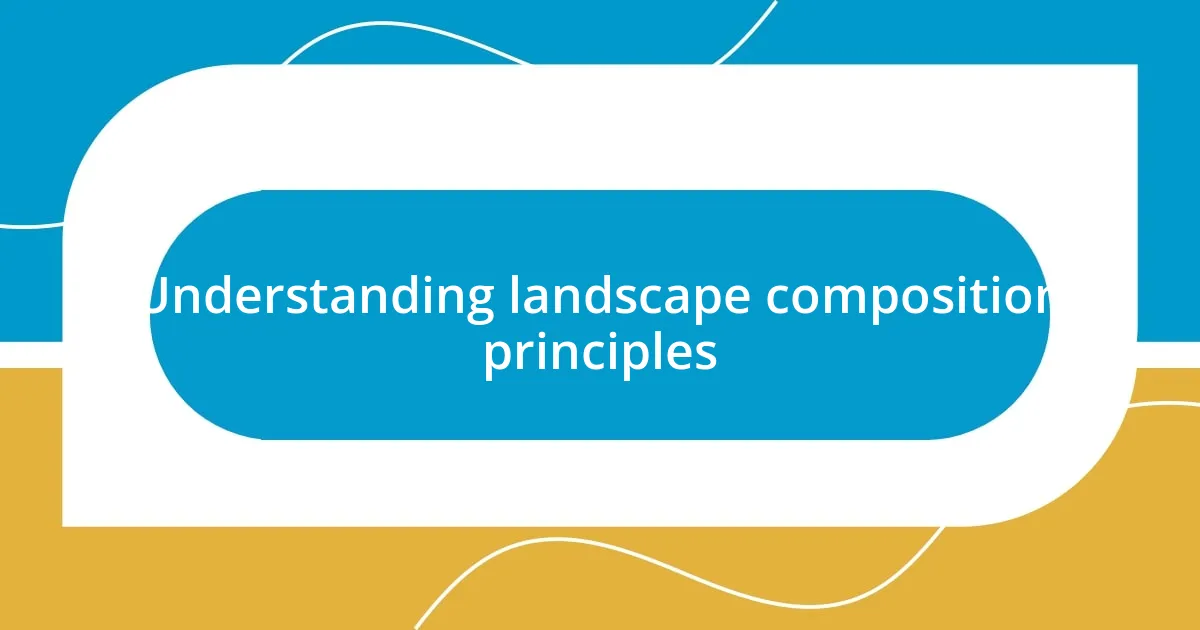Key takeaways:
- Understanding principles like the rule of thirds, leading lines, and balance creates visually appealing landscapes.
- Utilizing elements such as foreground interest, light and shadow, and color harmony enhances depth and emotional impact in photographs.
- Experimenting with perspectives and being patient for the right moment can significantly improve landscape photography.
- Capturing the changing seasons offers unique opportunities to convey emotion and connection in landscape images.

Understanding landscape composition principles
Understanding landscape composition principles begins with recognizing the rule of thirds. By dividing your frame into a grid of nine equal parts, you can align the elements in your scene along those lines or at their intersections. I remember my first time trying this at sunset; it felt almost magical to see how placing the horizon on the lower third naturally drew my eye into the vibrant sky above.
Another vital aspect is leading lines. These are paths or edges in a landscape that can guide the viewer’s eye toward the main subject. I often find myself wandering along a path in the woods, and each time, I’m captivated by how the trail pulls me into the heart of the scene. It’s as if the landscape beckons me to explore deeper, and I wonder: how does your eye move through your favorite photographs?
Don’t overlook the importance of balance and symmetry, either. They can create a sense of harmony in your work, making it visually appealing and comforting. I once captured a tranquil lake reflecting a perfectly framed mountain. The symmetry of that image gave me a profound sense of peace that I hope resonates with anyone who sees it. Isn’t it fascinating how simple principles can evoke such strong emotions in both the creator and the viewer?

Key elements of strong landscapes
A strong landscape is often built on the foundation of foreground interest. Including an engaging element in the foreground can help anchor your composition and create depth. I remember my hiking trip last summer, where I stumbled upon a field of wildflowers at sunrise. Their vibrant colors in the foreground complemented the majestic mountains in the backdrop, drawing my eye naturally across the scene and making the photo pop with life.
Another essential element to consider is the use of light and shadow. The quality of light changes throughout the day and can dramatically affect the mood of a landscape. I’ve often found that early mornings yield soft, golden light that can transform an ordinary scene into something extraordinary. On one occasion, as I stood beside a serene lake, the sunlight trickled through the trees, casting delicate shadows that danced over the water’s surface. That moment of interplay between light and shadow enhanced my photograph, adding layers of visual interest and emotional depth.
Lastly, think about color harmony. The right color palette can evoke different emotions and set the tone for your landscape. I typically aim for a balance between complementary colors to create a sense of cohesion without overwhelming the viewer. I once compared two shots: one was bold and vibrant, while the other embraced muted pastels. The latter resonated with a calm serenity, making it my personal favorite. Isn’t it intriguing how colors can influence our feelings and perceptions in such powerful ways?
| Key Element | Description |
|---|---|
| Foreground Interest | Engages the viewer and adds depth |
| Light and Shadow | Enhances mood and visual interest |
| Color Harmony | Creates emotional impact and cohesion |

Balancing foreground midground and background
When balancing the foreground, midground, and background in landscape composition, I find that it’s all about creating a visual journey. The foreground draws the viewer in, the midground offers context, and the background provides depth. I recall a visit to a national park where I positioned myself at a viewpoint overlooking a valley. The flowing river in the foreground led my gaze into the lush trees of the midground before arriving at the distant peaks. That layered depth made every element feel interconnected and breathed life into the entire scene.
- Foreground: Use elements like rocks or flowers to establish immediate interest and anchor the composition.
- Midground: Place additional features such as trees, hills, or buildings to provide a sense of context and transition.
- Background: Allow mountains or sky to frame the scene, creating depth and completing the story of the landscape.
It’s amazing how each layer contributes to the overall harmony of a photograph. Just the other day, while admiring a coastal sunset, I noticed how the rocks in the foreground helped to balance out the expansive sky and water. Without the foreground, the image would have felt flat and uninviting. It’s these thoughtful combinations that can turn an ordinary photo into something truly captivating.

Utilizing light and shadows effectively
I’ve always believed that light and shadows are the unsung heroes of landscape photography. During one memorable evening, I was at a secluded beach just as the sun dipped below the horizon. The deepening blue sky created stunning contrasts with the warm, golden reflections on the water. Watching the shadows stretch across the sand brought a sense of tranquility that I desperately wanted to capture. This interplay of light and dark not only highlighted the textures of the shoreline but also infused my photo with an emotional depth that evoked the calmness of that moment.
One technique I’ve found particularly effective is paying attention to how the angle of light enhances or diminishes features in a landscape. On a hike through a dense forest, I found that the low afternoon sun illuminated tree trunks beautifully, casting intricate shadows on the forest floor. Noticing how the light transformed the ordinary shapes around me into something almost magical made me pause and appreciate the moment. Have you ever found yourself captivated by the way light reveals hidden details in a seemingly mundane scene? It’s moments like these that remind me to keep my camera ready and my eyes open.
Lastly, understanding the emotional impact of light can shape your composition significantly. I recall photographing a misty morning where the soft light seemed to wrap around the hills, creating a dreamlike atmosphere. The gentle shadows added a layer of mystery that drew viewers in, making them curious about what lay beyond the mist. That subtle combination of light and shadow not only enhanced the aesthetic of my photograph but also resonated with feelings of nostalgia and wonder. Reflecting on these experiences confirms that the way light and shadow interact can fundamentally elevate your landscapes, transforming them from the ordinary to the extraordinary.

Techniques for creating depth
One of the techniques I cherish when creating depth in my landscape photos is the strategic use of leading lines. During a hike along a winding trail, I noticed how the path snaked through vibrant wildflowers, drawing the eye further into the scene. This natural line didn’t just serve as a guide; it invited viewers into the photograph, making them feel as if they could walk right into it. Have you ever considered how a simple trail can transform an image from static to immersive?
Incorporating elements that frame the composition can also add a profound sense of depth. I remember photographing a serene lake surrounded by tall pines. Positioning the camera just right allowed me to capture the branches in the foreground, enveloping the scene like a natural frame. This technique emphasizes the view beyond while creating an intimate feeling, almost as if the viewer is peeking into a hidden world. Isn’t it fascinating how framing can alter our perception of space and intimacy in a landscape?
Textures play a crucial role in conveying depth as well. One morning, while shooting a foggy meadow, I focused on the dew-covered grass in the foreground, which beautifully contrasted with the blurred trees behind. The difference in sharpness and clarity added layers to my image, giving viewers the sensation of scouting a mysterious landscape right before their eyes. It’s those textures—whether they’re rough bark or delicate petals—that can evoke a tactile response. What do you think? Do you often notice how textures can evoke emotion in photography? Feeling that connection can be a transformative experience, and I love exploring these nuances in my work.

Personal tips for landscape success
One personal tip that has truly enhanced my landscape photography is the importance of patience. I recall a day spent waiting for the right moment at a waterfall, the sun dancing on the water’s surface. Instead of rushing through the shot, I took a step back, allowing time to reveal subtle changes in light and shadow, and ultimately capturing a dynamic and vibrant image. Have you ever found that waiting for the perfect moment can transform your perspective? I’ve learned that sometimes, the most rewarding shots come when you give nature the chance to unfold at its own pace.
Another strategy I’ve embraced is experimenting with different perspectives. On one occasion, while exploring a breathtaking viewpoint, I climbed onto an outcropping to gain a higher vantage point. This shift made all the difference, allowing me to include dramatic foreground elements that added context and scale to the vast landscape below. Have you considered how a simple adjustment in your position can breathe new life into your images? It’s a thrilling reminder that each scene has layers just waiting to be uncovered.
Additionally, I find immense value in capturing the seasons. One winter evening, I ventured out during a snowstorm, and the world transformed into a serene wonderland. The ethereal beauty of the falling snow against the backdrop of dark evergreens created a hauntingly beautiful scene. This experience ignited a passion for documenting nature’s changing moods, showing me how each season presents unique opportunities to express emotion and connection. Do you ever think about how different times of the year can shape the stories your photographs tell? Embracing these seasonal shifts can enrich your portfolio and deepen your relationship with the landscapes you love to capture.














